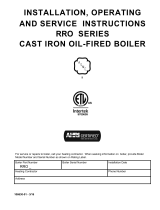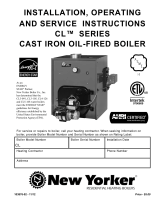
2
120 Volt Wiring1) - The boiler should be provided with its own 15A branch circuit with fused disconnect. 120VAC power con-
nections are made inside the L7248L as follows (also see Figures. 10.0 or 10.2 as appropriate for boiler model):
Hot (“black”) - Terminal “L1”•
Neutral (“white”) - Terminal “L2”•
Ground (“green” or bare) - Ground screw on case of L7248L.•
The circulator is either factory wired to the L7248L or the boiler is provided with a exible conduit “whip” that is factory
wired to the L7248L circulator connections. If the circulator is not already wired to the control, connect it as follows:
Circulator “Hot” - Black wire lead from “whip”•
Circulator “Neutral” - White wire lead from “whip”•
•
Low Voltage Connections2) – Low voltage eld connections are located as shown in Figure 10.0/10.2 and are as follows:
T-T• - Connect to a 24 volt heating thermostat or other “dry contacts” (such as a zone panel end switch) that close upon
a call for heat. Follow thermostat manufacturer’s instructions. To insure proper thermostat operation, avoid installation
in areas of poor air circulation, hot spots (near any heat source or in direct sunlight), cold spots (outside walls, walls
adjacent to unheated areas, locations subject to drafts). Provide Class II circuit between thermostat (or zone controls) and
boiler.
1,2,3• - Used to connect EnviraCom thermostat, or other EnviraCOM device, approved by Crown for use with this boiler
(refer to instructions provided with EnviraCOM device).
Adding a Second Circulator Zone3) - The L7248L provided with this boiler can be used to control a second heating or DHW
circulator zone. If this is done, make the following 120VAC connections in addition to those described above (also see Figure
10.0 or 10.2):
Connect a 120VAC heating or DHW thermostat for the second zone between L1 and ZR. •
Connect the circulator for the second zone between ZC and L2. •
See Part XII of this manual for information on conguring the control to respond properly to this second zone.
Low Water Cut-offs4) - A properly installed low water cut-off (LWCO) prevents burner operation in the event that there is
insufcient water in the boiler. Many jurisdictions require the installation of a LWCO, as does NFPA-31. Install the LWCO
in the supply piping immediately above the boiler with no intervening valves. If a probe type LWCO is used, observe the
LWCO manufacturer’s required clearances around the probe. Use a LWCO that is wired so as to interrupt 120volt power to
the boiler in the event of a low water condition.
Crown 120V FWZ/TWZ LWCO Kit #411000 includes the LWCO, ttings, and wiring needed to meet the above
requirements.
CAUTION
When making low voltage connections, make sure that no external power source •
is present in the thermostat circuits. If such a power source is present, it could
destroy the boiler’s control. One example of an external power source that could
be inadvertently connected to the low voltage connections is a transformer in old
thermostat wiring.
Do not attempt to use EnviraCOM connections for any purpose not explicitly permitted •
by Crown Boiler Company. Attempting to do so may result in unreliable operation and/
or damage to controls.
Do not use the transformer provided on the boiler to power external devices such as •
zone valves. Doing so may cause damage to the transformer.



















